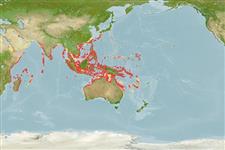Teleostei (teleosts) >
Syngnathiformes (Pipefishes and seahorses) >
Centriscidae (Snipefishes and shrimpfishes) > Centriscinae
Etymology: Aeoliscus: Derived from Aeolius, region from Asia Minor and Aeolus, the Greek god of winds (Ref. 45335).
More on author: Günther.
Environment: milieu / climate zone / depth range / distribution range
Ecology
Marine; reef-associated; depth range 2 - 42 m (Ref. 90102). Tropical; 32°N - 32°S, 38°E - 170°E
Indo-West Pacific: Tanzania (Ref. 51015) and Seychelles (Ref. 1623); then from southern Japan to New South Wales, Australia eastward to Vanuatu.
Size / Weight / Age
Maturity: Lm ? range ? - ? cm
Max length : 15.0 cm TL male/unsexed; (Ref. 1602)
Short description
Morphology | Morphometrics
Dorsal
spines
(total): 3;
Dorsal
soft rays
(total): 9-10;
Anal
spines: 0;
Anal
soft rays: 12. Recognized by hinged part of dorsal fin spine. Variable in color with habitat. Greenish-yellow with diffused stripe when in seagrass environment. Pale with black stripe when found on open substrate with white sand or rubble (Ref. 48635).
Form schools among the spines of Diadema or staghorn corals, and feed on minute crustaceans in the zooplankton. Remarkable for their strange body shape and swimming habit: the body is encased in an armor of thin, transparent plates; they swim in synchronized groups, each fish in a vertical position with the snout pointing downwards.
Life cycle and mating behavior
Maturity | Reproduction | Spawning | Eggs | Fecundity | Larvae
Myers, R.F., 1991. Micronesian reef fishes. Second Ed. Coral Graphics, Barrigada, Guam. 298 p. (Ref. 1602)
IUCN Red List Status (Ref. 130435)
Threat to humans
Harmless
Human uses
Fisheries: of no interest; aquarium: commercial
More information
Common namesSynonymsMetabolismPredatorsEcotoxicologyReproductionMaturitySpawningSpawning aggregationFecundityEggsEgg development
ReferencesAquacultureAquaculture profileStrainsGeneticsElectrophoresesHeritabilityDiseasesProcessingNutrientsMass conversion
Tools
Special reports
Download XML
Internet sources
Estimates based on models
Preferred temperature (Ref.
123201): 25.2 - 29.3, mean 28.6 °C (based on 2830 cells).
Phylogenetic diversity index (Ref.
82804): PD
50 = 0.7502 [Uniqueness, from 0.5 = low to 2.0 = high].
Bayesian length-weight: a=0.00282 (0.00106 - 0.00750), b=3.10 (2.86 - 3.34), in cm total length, based on LWR estimates for this (Sub)family-body shape (Ref.
93245).
Trophic level (Ref.
69278): 3.5 ±0.48 se; based on food items.
Resilience (Ref.
120179): High, minimum population doubling time less than 15 months (Preliminary K or Fecundity.).
Fishing Vulnerability (Ref.
59153): Low vulnerability (10 of 100).
Nutrients (Ref.
124155): Calcium = 98.1 [55.6, 172.3] mg/100g; Iron = 0.802 [0.478, 1.329] mg/100g; Protein = 17.7 [16.5, 18.8] %; Omega3 = 0.119 [0.067, 0.212] g/100g; Selenium = 28 [15, 64] μg/100g; VitaminA = 191 [68, 523] μg/100g; Zinc = 1.5 [1.0, 2.1] mg/100g (wet weight);
